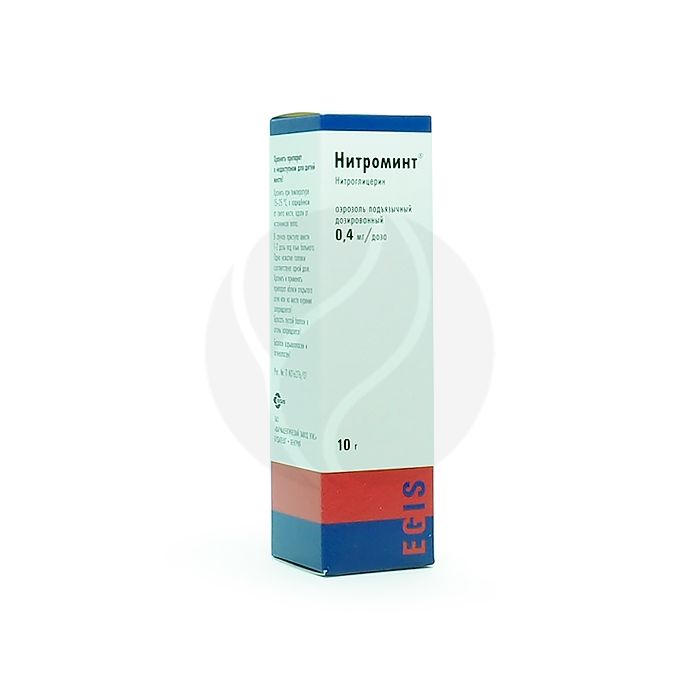Nitromint spray 0.4mg / dose, 10g (180 doses)
Expiration Date: 05/2027
Russian Pharmacy name:
Нитроминт спрей 0,4мг/доза, 10г (180 доз)
angina pectoris (relief and prevention of seizures, including before exercise);
acute left ventricular failure (as adjunctive therapy).
Sublingual. Before using the cylinder for the first time, prime the metering pump by removing the protective cap and pressing the metering valve several times until a spray appears.
After a long period of non-use of the cylinder, it may be necessary to refill the pump.
When in use, the can should be held vertically with the spray head up. Each press of the metering valve releases 1 dose (0.4 mg of nitroglycerin) in the form of a spray from a cylinder equipped with a mechanical pump. You do not need to shake the can before use.
To stop an attack of angina pectoris: 0.4-0.8 mg (1-2 doses), press the metering valve, preferably in a sitting position, while holding the breath at intervals of 30 seconds; after that, you should close your mouth for a few seconds. If necessary, repeated administration, but not more than 1.2 mg (3 doses) within 15 minutes.
To prevent the development of an attack - 0.4 mg (1 dose) 5-10 minutes before the load.
In acute left ventricular failure, developing pulmonary edema: 1.6 mg (4 doses) or more in a short period of time with strict control of the state of blood circulation (SBP should be> 100 mm Hg). If the therapeutic effect is insufficient, the same dose can be repeated after 10 minutes.
No change in the dosage regimen is required when using the drug in elderly patients.
| Sublingual metered spray | 1 bottle |
| active substance: | |
| nitroglycerine | 0.08 g |
| (as a 1% solution) | |
| excipients: ethanol (96%) - 7.92 g; propylene glycol - 2 g |
hypersensitivity to organic nitrates;
shock;
collapse;
age up to 18 years (lack of sufficient clinical data).
With care: acute circulatory failure, accompanied by severe arterial hypotension (SBP below 90 mm Hg); orthostatic hypotension; hemorrhagic stroke; acute myocardial infarction and chronic heart failure with low left ventricular filling pressure; hypertrophic cardiomyopathy; severe renal and / or hepatic impairment; severe anemia and thyrotoxicosis; alcoholism; epilepsy; traumatic brain injury; intracranial hypertension; angle-closure glaucoma (risk of increased IOP); migraine.

